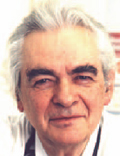The eLitMed.hu medical portal uses computer cookies for convenient operation. Detailed information can be found in the Cookie-policy.
Lege Artis Medicinae - 2007;17(11)
Content
[PAIN RELIEF IN THE CLINICAL PRACTICE - THE USE OF MAJOR ANALGETICS]
[The use of opioids to relieve strong, unbearable pain is a method that has been known for thousands of years and is still effective today. In contrast to the earlier view, opioids today are not only given to cancer patients. The application area of morphine derivatives is generally the relief of exceptionally strong pain regardless of the diagnosis, but opiates are undoubtedly most commonly used to treat cancer-related or strong acute pain. Strong pain reducers are used much more in developed countries for the treatment of non-cancer related severe pain refractory to other approaches. Today the use of opiates and their derivatives (fentanyl, oxycodon) for non-cancer related pain relief is recognized by the national health insurance in that it allows general practitioners to prescribe them, upon the recommendation of a neurosurgeon, orthopaedic surgeon, traumatologist or rheumatologist, with a significant 90% subsidy for six months to ensure easy access for patients in severe, refractory pain due to degenerative musculoskelatal diseases (ICD: M47, M48, M16.9, M17.9, M54.4, M51.0, M51.1). The indications of opioid use, however, are not limited to strong nociceptive pain since they are also effective in certain types of peripheral neuropathic pain. In brief, a basic principle of the use of major analgetics is that their indication is primarily based on the intensity of pain and not on the nature of the disease, even though the latter has a major influence on the clinician's strategy of pain relief.]
[INFLAMMATION AND ATHEROSCLEROSIS]
[The role of vascular wall inflammation in the pathogenesis of atherosclerosis is becoming increasingly clear. However, the causal relationship between the inflammation and the course of atherosclerosis, which begins in childhood and continues for life, is debated in the literature. The interpretation of the basic pathophysiologial essence of inflammation is also controversial. This paper summarizes the basics and various features of inflammation, the body's defensive and aversive reaction. The “acute phase reaction syndrome” is a general, immediate, non-specific defense reaction of the organism, which is strongly associated with the specific, adaptive immune response. There are inflammatory processes that are chronic from the start. When looking at the main types and functions of the arterial wall proteoglycans, it is clear that they, along with the lipoprotein receptors and HDL cholesterol, are closely connected to the process, course and characteristics of the inflammation. The arterial wall proteoglycans are definitely capable of directly and indirectly influencing the inflammatory process. The issue of a possible target of statin derivatives other than the inhibition of cholesterol biosynthesis has not been resolved. Atherosclerosis may be considered a primarily chronic individual vasculitis syndrome that involves all layers of the blood vessels, and is determined by the risk factors and by the special structure of the arterial wall. The presence of inflammation is a prerequisite to the development and throughout the entire course of atherosclerosis.]
[HAEMOGLOBIN CYCLICITY IN RENAL ANAEMIA]
[Erythropoiesis stimulating agents are glycoproteins in which the oligosaccharide chains that terminate in sialic acid bind to the peptide with glycosidic bond. The lower the sialic acid content of the erythropoietin, the higher its receptor affinity, while its half-life in the circulation decreases. The biological effect depends on the balance of these factors. In the third-generation erythropoiesis stimulating molecule CERA (continuous erythropoietin receptor activator) a large polyethylene glycol molecule is substituted for sialic acid to ensure slow elimination and better biological efficiency. During treatment with erythropoiesis stimulating agents, haemoglobin levels show cyclic fluctuation. This cyclicity is undesirable, so its frequency and amplitude should be reduced as much as possible. The most recent results suggest that CERA may reduce haemoglobin cyclicity.]
[OUR EXPERIENCE WITH COMBINED ANTIVIRAL TREATMENT IN PATIENTS WITH CHRONIC HEPATITIS C WITH PERSISTENTLY NORMAL ALANINE AMINOTRANSFERASE LEVELS]
[INTRODUCTION - Persistently normal alanine aminotransferase levels, which occur in a fraction of patients chronically infected with hepatitis C virus, do not rule out the presence of chronic hepatitis C, even of that with advanced inflammation and fibrosis. Here we report our results of the treatment of these patients. PATIENTS AND METHODS - Patients with histologically confirmed chronic hepatitis C received combined antiviral treatment with pegylated interferon (alfa-2a 1×180 μg/week or alfa-2b 1×1.5 μg/kg/week) and ribavirin (800- 1200 mg/day) for 48-52 weeks. The alanineaminotransferase levels of 21 patients (14 females, 7 males, age: 20-54, mean 38 years) did not reach the upper limit of normal (40 U/l) during the period of observation (≥6 months). There were 19 and 2 cases with hepatitis C virus genotype 1b and 3, respectively. The patients' hepatitis activity index was 3.7 1.75, fibrosis score: 0.9 0.64, baseline viral titer: 1.18 1.12×106 IU/ml, alanine-aminotransferase level: 33.51 7.2 U/l. The last 100 unselected patients with elevated alanine-aminotransferase levels enrolled in treatment for chronic hepatitis C and who were followed for at least 6 months served as the control group with the following parameters: 41 females and 59 males (age: 18- 65, mean: 45.65 years), viral genotypes: 98 and 2 cases of type 1 and 3, respectively, hepatitis activity index: 5.44±4.03, stage: 1.29±1.00, baseline viral titer: 4.13±6.25×106 IU/ml. RESULTS - In the study group, all patients were hepatitis C virus RNA negative at the end of the treatment and with one exception remained so by the end of the 6-month follow-up period (20/21), while the sustained virologic response was 36% in the control group. The pretreatment normal alanine aminotransferase level decreased significantly (15.26 4.9 vs 33.51 7.2 U/l, p<0.001) by the end of the treatment, and remained at this level during the follow-up in all except one relapse case. CONCLUSION - The efficacy of the combined antiviral treatment is high in patients with persistently normal alanine aminotransferase levels, possibly due to the relatively younger age, the higher proportion of females, the lower baseline viral titer, and the less advanced liver disease (lower inflammatory activity and less or absent fibrosis) observed in this group. Combined antiviral treatment is recommended for patients with histologically confirmed chronic hepatitis C with normal alanine aminotransferase levels, even with mild inflammatory activity and minimal or absent fibrosis in the liver tissue. The previous suggestions based on published evidence to revise the upper limit of the normal range of alanine aminotransferase level are supported by the results of this study.]
[HUMAN LEUKOCYTE INTERFERON IN THE TREATMENT OF CHRONIC HEPATITIS C]
[INTRODUCTION - Approximatively 50% of the patients with chronic hepatitis C do not respond properly to pegylated interferon-alpha+ribavirin treatment and according to the therapeutic guidelines their treatment must be interrupted. The authors examined whether their further medication with human leukocyte interferon is justified. PATIENTS AND METHODS - Thirty-eight patients with chronic hepatitis C were treated with human leukocyte interferon who had responded to pegylated interferon-alpha-ribavirin treatment, but dropped out of the treatment scheme based on the therapeutic criteria on week 12 or 24. RESULTS - While only 3 patients responded with persistent virological negativity, mean alanine aminotransferase (ALT) levels decreased during treatment and persistently remained lower than the baseline levels. Except for the three responders, the HCV viral load as determined by polymerase chain reaction did not decrease but even increased on average. Patients tolerated the treatment well. Known side-effects were observed in 6 cases, and treatment had to be interrupted in one case. These are proportionally far less than the respective 20 to 25% and 5 to 15% reported for peginterferon-ribavirin treatment. CONCLUSION - Even though virological recovery is rare, the reduction in inflammatory activity, the expected slowing of progression, and, in particular, the definite improvement of the cryoglobulinaemic purpura and vasculitis warrant switching to human leukocyte interferon treatment in selected cases.]
[TREATMENT OF ANAEMIA IN A PATIENT WITH SMALL CELL LUNG CANCER]
[INTRODUCTION - Anaemia is a common complication among patients with malignant tumours, and is due to the disease itself or to the oncologic treatment. Anaemia worsens the patient’s quality of life and hampers anti-cancer treatment in the appropriate intervals and doses. Erythropoiesis stimulating protein therapy in the anaemia of oncologic patients raises the haemoglobin level, reduces the need for red blood cell transfusion and improves quality of life. This drug has recently become accessible in Hungary for the treatment of chemotherapy-induced anaemia in patients with small cell lung cancer. CASE REPORT - In this paper the case of a 64- year-old woman with small cell lung cancer who survived for more than 2 years is presented. Two-line chemotherapy was administered together with irradiation and darbepoetin alpha supportation. The successful treatment of anaemia with darbepoetin alpha permitted the administration of chemotherapy in the necessary intervals and doses. CONCLUSIONS - The adequate use of erythropoiesis stimulating protein facilitates the management of patients with small cell lung cancer, and improves their quality of life.]
[NEUROVASCULAR COMPRESSION IN THE MEDULLA OBLONGATA AS A CAUSE OF RESISTANT HYPERTENSION - THOUGHTS APROPOS OF A PATIENT]
[INTRODUCTION - The vasomotor centre, the central regulator of the cardiovascular system, is localised in the rostral ventrolateral medulla oblongata. Irritation of this area and/or of the ninth and tenth cranial nerves (that are involved both in the afferent and efferent pathways of the baroreceptor reflex) causes sympathetic hyperactivity, which in some cases leads to severe resistant hypertension. A common underlying cause of this is pulsatile neurovascular compression, a vascular malformation rarely sought for. CASE REPORT - The authors present the case of a middle-aged woman with what had been considered “essential” hypertension. Magnetic resonance angiography showed vascular compression of the medulla oblongata and the departing left ninth and tenth cranial nerves as the cause of her hypertension. CONCLUSIONS - After a literature review the authors draw the attention to this rarely identified cause of resistant hypertension and to the difficulties of its diagnosis.]
1.
Clinical Neuroscience
Is there any difference in mortality rates of atrial fibrillation detected before or after ischemic stroke?2.
Clinical Neuroscience
Factors influencing the level of stigma in Parkinson’s disease in western Turkey3.
Clinical Neuroscience
Neuropathic pain and mood disorders in earthquake survivors with peripheral nerve injuries4.
Journal of Nursing Theory and Practice
[Correlations of Sarcopenia, Frailty, Falls and Social Isolation – A Literature Review in the Light of Swedish Statistics]5.
Clinical Neuroscience
[Comparison of pain intensity measurements among patients with low-back pain]1.
Clinical Neuroscience Proceedings
[A Magyar Stroke Társaság XVIII. Kongresszusa és a Magyar Neuroszonológiai Társaság XV. Konferenciája. Absztraktfüzet]2.
3.
Journal of Nursing Theory and Practice
[A selection of the entries submitted to the literary contest "Honorable mission: the joys and challenges of our profession" ]4.
Journal of Nursing Theory and Practice
[End of Life and Palliative Care of Newborns in the Nursing Context]5.
Journal of Nursing Theory and Practice
[Aspects of Occupational Health Nursing for Incurable Patients ]
























